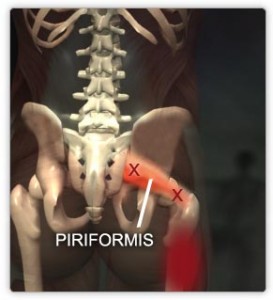 The piriformis syndrome is a condition in which the piriformis muscle irritates the sciatic nerve, causing pain in the buttocks and referring pain along the course of the sciatic nerve. This referred pain, called “sciatica”, often goes down the back of the thigh and/or into the lower back. Patients generally complain of pain deep in the buttocks, which is made worse by sitting, climbing stairs, or performing squats. The piriformis muscle assists in abducting and laterally rotating the thigh. In other words, while balancing on the left foot, move the right leg directly sideways away from the body and rotate the right leg so that the toes point towards the ceiling. This is the action of the right piriformis muscle.
The piriformis syndrome is a condition in which the piriformis muscle irritates the sciatic nerve, causing pain in the buttocks and referring pain along the course of the sciatic nerve. This referred pain, called “sciatica”, often goes down the back of the thigh and/or into the lower back. Patients generally complain of pain deep in the buttocks, which is made worse by sitting, climbing stairs, or performing squats. The piriformis muscle assists in abducting and laterally rotating the thigh. In other words, while balancing on the left foot, move the right leg directly sideways away from the body and rotate the right leg so that the toes point towards the ceiling. This is the action of the right piriformis muscle.
Anatomically, the piriformis muscle lies deep to the gluteal muscles. It originates from the sacral spine and attaches to the greater trochanter of the femur, which is the big, bony “bump” on the outside top of the thigh. The sciatic nerve usually passes underneath the piriformis muscle, but in approximately 15% of the population, it travels through the muscle. It is thought that acute or chronic injury causes swelling of the muscle and irritates the sciatic nerve, resulting in sciatica. Patients with an aberrant course of the nerve through the muscle are particularly predisposed to this condition.
The piriformis syndrome is diagnosed primarily on the basis of symptoms and on the physical exam. There are no tests that accurately confirm the diagnosis, but X-rays, MRI, and nerve conduction tests may be necessary to exclude other diseases. Some of the other causes of sciatica include disease in the lumbar spine (e.g. disc herniation), chronic hamstring tendinitis, and fibrous adhesions of other muscles around the sciatic nerve.
Once properly diagnosed, treatment is undertaken in a stepwise approach. Initially, progressive piriformis stretching is employed, starting with 5 seconds of sustained stretch and gradually working up to 60 seconds. This is repeated several times throughout the day. It is important that any abnormal biomechanical problems, such as overpronation of the foot or other coexisting conditions, are treated. This stretching can be combined with physical therapy modalities such as ultrasound. If these fail, then injections of a corticosteroid into the piriformis muscle may be tried. Finally, surgical exploration may be undertaken as a last resort.
A good sports medicine physician with experience in caring for athletes with the piriformis syndrome can help direct appropriate management. With proper diagnosis and treatment, there is no reason for this syndrome to be dreaded.
There are different treatments depending on condition which Dr.Kevin yip will advise during the consultation, if there is a need for a treatment or surgery. For an appointment with Dr.Kevin yip please call +65 6471 2691(24hours)
